
Canidae is a biological family of dog-like carnivorans, colloquially referred to as dogs, and constitutes a clade. A member of this family is also called a canid. The family includes three subfamilies: the extant Caninae and the extinct Borophaginae and Hesperocyoninae. The Caninae are known as canines, and include domestic dogs, wolves, coyotes, foxes, jackals and other extant and extinct species.

Borophagus is an extinct genus of the subfamily Borophaginae, a group of canids endemic to North America from the Middle Miocene epoch through the Early Pleistocene epoch 12—1.8 Mya.

Aelurodon is an extinct canid genus of the subfamily Borophaginae which lived from the Barstovian land mammal age of the middle Miocene to the late Miocene epoch. Aelurodon existed for approximately 10.7 million years.
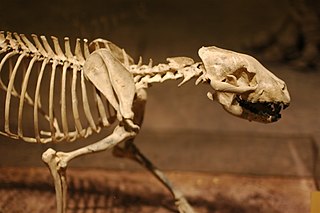
The extinct Borophaginae form one of three subfamilies found within the canid family. The other two canid subfamilies are the extinct Hesperocyoninae and extant Caninae. Borophaginae, called "bone-crushing dogs", were endemic to North America during the Oligocene to Pliocene and lived roughly 34—2.5 million years ago, existing for about 33.5 million years.

The extinct Hesperocyoninae are one of three subfamilies found within the canid family. The other two canid subfamilies are the extinct Borophaginae and extant Caninae.
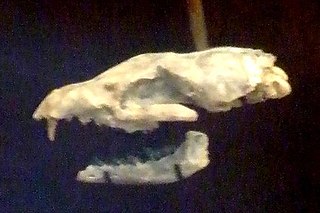
Archaeocyon is an extinct genus of the Borophaginae subfamily of canids native to North America. It lived during the Oligocene epoch 32-24 Ma., existing for approximately 8 million years. Species of Archaeocyon are among the earliest known borophagines, although a species of Otarocyon has a slightly earlier first appearance. Fossils have been found across the northern Great Plains and along the west coast of North America.

Tomarctus is a canid genus of the extinct subfamily Borophaginae which inhabited most of North America during the late Early Miocene to the Early Barstovian age of the Middle Miocene. Tomarctus existed for approximately 6.83 million years.
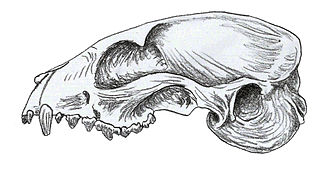
Otarocyon is an extinct genus of the Borophaginae subfamily of canids native to North America. It lived during the Oligocene epoch, about 33.3—20.6 Ma. Fossils have been found only in Montana, Wyoming, and South Dakota.
Euoplocyon is an extinct genus of the Borophaginae subfamily of canids native to North America. It lived during the Early to Middle Miocene, 20.6—13.6 Mya, existing for about 7 million years. A member of the Borophagini tribe, it was an intermediate-sized canid, with specialisations towards a heavily meat-based diet.

Paratomarctus is an extinct monospecific genus of the Borophaginae subfamily of canids native to North America. It lived from the Middle to Late Miocene, 16.3 – 5.3 mya, existing for approximately 11 million years. It was about the size of a coyote, and was probably a generalised predator, without the specialised adaptations of most later borophagines.
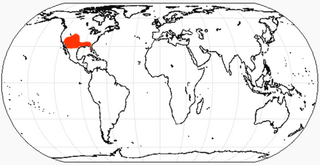
Carpocyon is an extinct genus of the Borophaginae subfamily of canids native to North America. It lived from the Middle to the Late Miocene, 13.6 to 5.3 Ma Mya, existing for approximately 16.5 million years. The four species in the genus varied in size, with the largest being about the size of a wolf; all had relatively small teeth, suggesting a diet that was more omnivorous than that of other contemporary borophagines.
Borophagina is a subtribe of the Borophaginae, a group of extinct canids. They inhabited much of North America from the Early Miocene to the Zanclean stage of the Pliocene, 20.6—3.6 Mya, and existed for approximately 17 million years.
Borophagus parvus is an extinct species of the genus Borophagus, of the subfamily Borophaginae, a group of canids endemic to North America from the late Hemphillian of the Miocene epoch through the Pliocene epoch 10.3—4.9 Ma, existing for approximately 5.4 million years.
Borophagus dudleyi is an extinct species of the genus Borophagus of the subfamily Borophaginae, a group of canids endemic to North America from the late Hemphillian of the Miocene epoch through the Pliocene epoch. Borophagus dudleyi existed for approximately 5.4 million years.
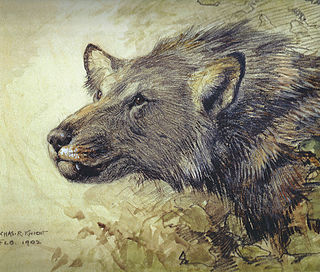
Borophagus hilli is an extinct species of the genus Borophagus of the subfamily Borophaginae, a group of canids endemic to North America from the Late Miocene until the Pliocene.

Borophagus diversidens is an extinct species of the genus Borophagus of the subfamily Borophaginae, a group of canids endemic to North America from the late Miocene epoch through the Pliocene epoch 4.9—1.8 Ma.

Borophagus littoralis is an extinct species of the genus Borophagus of the subfamily Borophaginae, a group of canids endemic to North America from the early Miocene epoch through the Pliocene epoch. Borophagus littoralis existed for approximately 18.4 million years.
Borophagus orc is an extinct species of the genus Borophagus of the subfamily Borophaginae, a group of canids endemic to North America from the 10.3 Mya to 4.9 Mya. Borophagus orc existed for approximately 5.4 million years.
Borophagus pugnator is an extinct species of the genus Borophagus of the subfamily Borophaginae, a group of canids endemic to North America from the early Miocene epoch through the late Miocene epoch 23.3—5.3 Ma. Borophagus pugnator existed for approximately 18 million years.

Borophagus secundus is an extinct species of the genus Borophagus of the subfamily Borophaginae, a group of canids endemic to North America from the Early Miocene epoch through the Late Miocene epoch. Borophagus secundus existed for approximately 17.7 million years.














